How to assemble Push Lock, PTFE, AN fitting and hose (Part 2)
How to assemble Push Lock, PTFE, AN fitting and hose (Part 2)
Our next line that we are going to go ahead, and use is the PTFE.
The second one: PTFE Fitting
So, I will go ahead and cut the end of real clean quick and we will get to assembling You can see even though the stainless outer braiding. It just is such a smooth cut, does not fray at all and gives us a nice clean end to working with.
To the untrained eyes these two looks very similar and within brands the way this piece is shaped is different. So, the main thing is that you want to make sure if you are assembling PTFE hose.
That you have PTFE fittings. They are not reversible the two and you will see why so. This is a standard AN fitting and you can see how it looks when it comes apart. This is a PTFE fitting. When it comes apart you will see there is actually an extra piece inside and this portion here is shaped a lot of different. PTFE hose has different components than AN fitting.
So you have your main body here. You have your olive as a lot of people call it.
And you have your Mach the same as what is on the AN fitting. The biggest tip if you have never done a PTFE fitting. Is to make sure that you know to put the nut on the hose before you start working on the putting the olive in. So how you do that is to make sure you have a nice clean-cut end, as we showed earlier. And you just kind of work that on and slide it back.
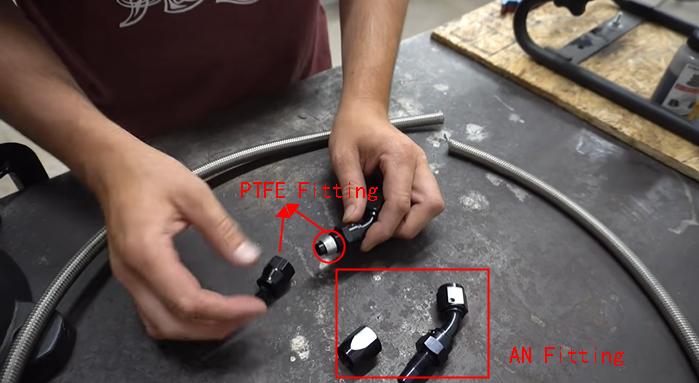
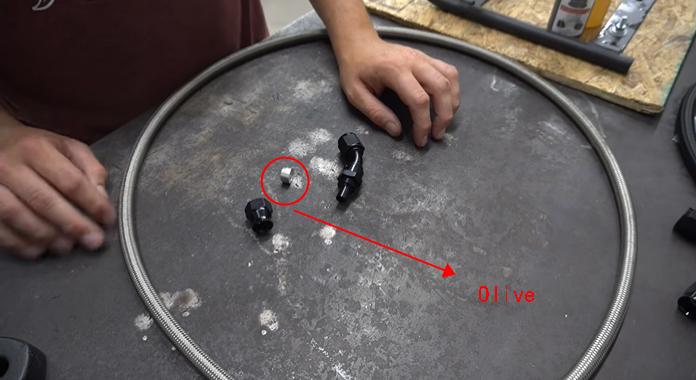
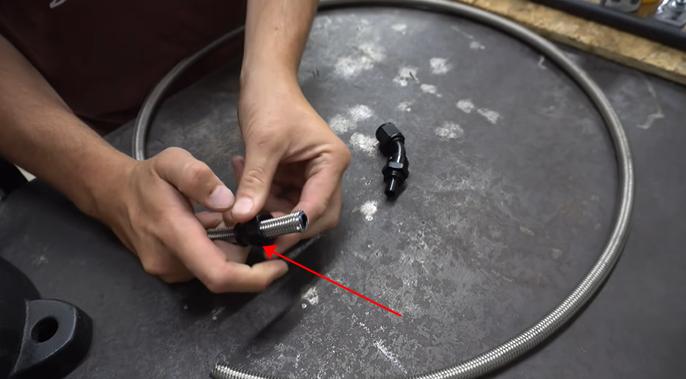
So, the next step what we are trying to do is wedge this tapered portion in between the outer steel braiding and the PTFE and internally. So takes a little bit there is a couple tools they sell for this that make it really easy, and this is basically the only tricky part of a PTFE fitting.
So definitely a place you can cut your fingers if you are doing it by hand, but it is as simple as that. And what I would do is I try to get that in there as far as possible. So, you can either tap it down on the table until that tubing is right there at the very top. Or you can tap it with a hammer of whatever. Just make sure it is nice and square so that when you go to start the hose end itself. What you are working with is something that is going to line up square.
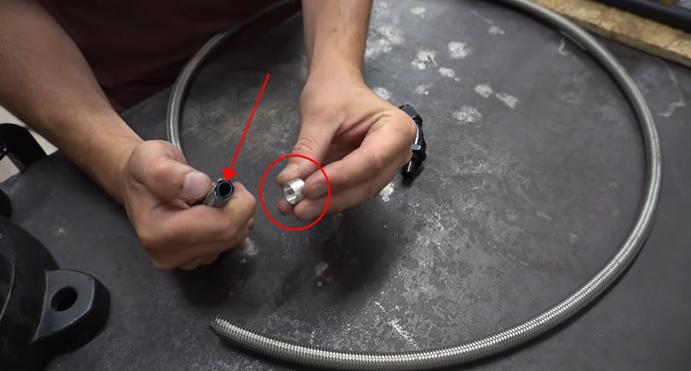
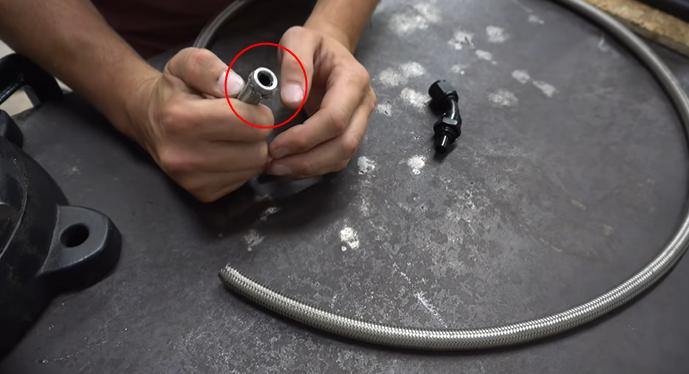
So now what all this is going to do is go inside of this and as you tighten the nut down. It is going to just basically create a wedge between that outer and inner and yeah, we will have a nice secure fitting that holds a lot of pressure. What you will want to do is get yourself a larger size center punch than this. Otherwise, you are going to end up using a screwdriver trying to like basically to push that PTFE around the edge out there.
If you do not properly push it in, if you look inside of here, you will see that as the center part pushed in it actually folded over. So that is going to create a bad seal and you are likely going to have a leak from that and or just a something that will pop up later if it does not leak right off the bat. It is definitely going to cause you issues later on down the road. So once you get that all seated and wedged out. It is basically just going to press inside of there and you are going to sit flush.
Now one tip that you are when you are assembling any of these hose ends. You can always spray it with a little bit of silicone and do that when you are assembling the nut to the main body.
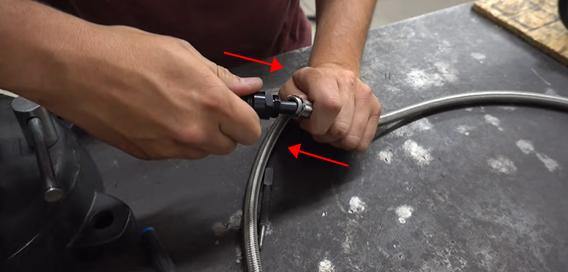
Because that is gonna keep from stripping these threads out if you do not have them perfectly aligned and you have no lubrication. There is a very good chance you are either going to strip out or cross thread things a lot easier. It is a little bits right there. That is actually a lot of bit and we are going to basically just work this out onto here. And try and square it up best you can and get things started.
Once you get things started, we are going to go ahead and go ahead and move it over to the vise. So, if you do not have a set of these magnetic vise jaws. They save your life. The nice thing is they can be used this way or this way. So, whatever is you know easier for you to do.

So that you guys can see a little bit better I will actually just put it on that magnetic vise jaws in this way. And you just line it up tighten it. It is aluminum So it does not scratch the nut would just try not to tighten it too tight because you might actually distort the nut which will put pressure on the threads.
And just another way you can strip it out and if you do not have a set of these. An wrench the best thing I can tell you is to spend money on some good ones. The cheap ones are made out of 6061 or worse material and they what they do is they just flex right here at the head. So, spend a little bit of money, do some investigation and buy a good one.
So, with all these hoses, when you are assembling them, you always want to make sure that the hose is not pushing out. There is always that opportunity that will obviously create a bad situation and from here. All you are going to do is tighten your main body to the B nut.
It is going to create that interference that we are looking for and you will basically either want to bottom it out or go as far as you can until it is very very tight as possible.
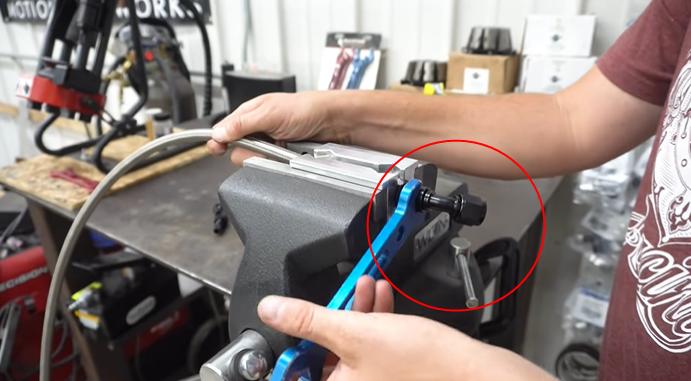
If it is not tight and you have a big gap in this area it is probably not compressed enough to create a real great seal especially on AN hose. But also, on PTFE and what you have at the end is a good solid connection and with PTFE you can. It can hold huge amounts of pressure.
So, the one difference in PTFE and regular AN hose, they both have industry standard sizes and specifications. But right off the bat if you look at them when you pull PTFE hose these are both number eight. So, you can see the nut on the side of the fitting is the same size, so they are obviously the same size.
So just some little tip for you guys if I had not said it already, PTFE fittings go with PTFE hose and fittings go with AN hose. There is no mixing them up as far as hose ends go. They have to be used together.
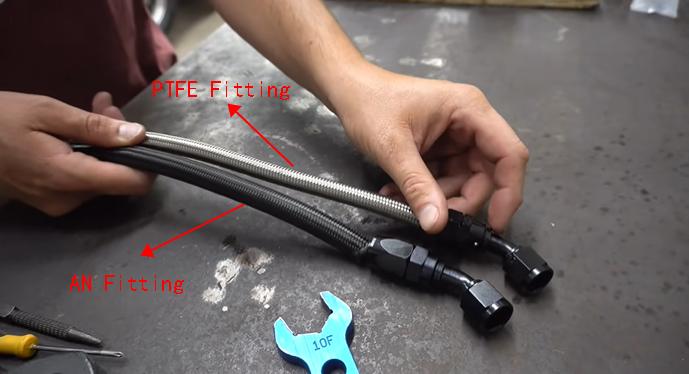
So, if you do not have that olive and nut, then it is not going to be right for the PTFE hose. Just make sure you are paying attention when you are ordering. They look the same you can easily mix them up. And you just want to make sure you get it right the first time.